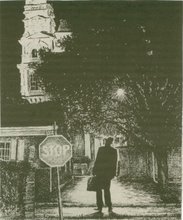
Some writers write engagingly about a single subject, secret codes say. Others—and these include our most versatile—seem able to handle anything with power and panache.
In her new novel, Waiting for Rescue (Counterpoint, $14.95), her first since the Maine Novel Prize-winning Picking Up, Honig takes on another of the significant issues of our times, the effect of the events of 9/11 on those of us who may not have been personally impacted by that tragedy but who have nevertheless been traumatized by the terrorist attacks on the World Trade Center and the Pentagon and their reverberations.
Erika, the protagonist in this compelling novel, teaches writing in the public health department of a major
As she struggles to help her students grapple with their research projects, Erika also contends with the interpersonal politics of the department where she teaches—the appointment of a chairperson who is unpopular with the faculty, the rise of incompetent staff, unwelcome changes in her teaching routine. She enters into an uneasy relationship with Ivan, a Russian doctor with whom she works, all the while obsessing over an unthinkable crime committed many years earlier by her former high school biology teacher, who, she learns, has recently been released from prison.
But as Erika’s story unfolds, intercut by her doomed affair with Ivan, the fate of one of her students, Ibrahim, a doctor from
It becomes clear as Honig’s compelling narrative gathers momentum that Erika, like many of us living through the after-effects of 9/11, is suffering from a form of Post Traumatic Stress Disorder. It emerges in her uncharacteristically hostile behavior toward colleagues, her fixation on the crime of her former teacher and her increasingly disturbing dreams of disaster. Sadly, her powerfully rendered journey to Ground Zero with Ivan, coupled with memories of having traveled on the subway under the
The concluding chapter of the novel, in which Erika travels by bus and by foot through a
The author will be reading from Waiting for Rescue on Thursday, October 29 at 7 p.m. at the Book Store in downtown
This review first appeared in the September 29, 2009 issue of


No comments:
Post a Comment